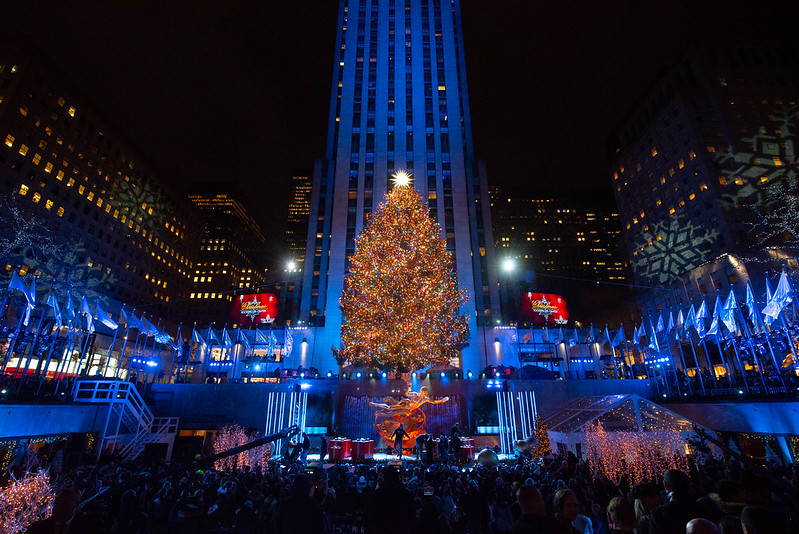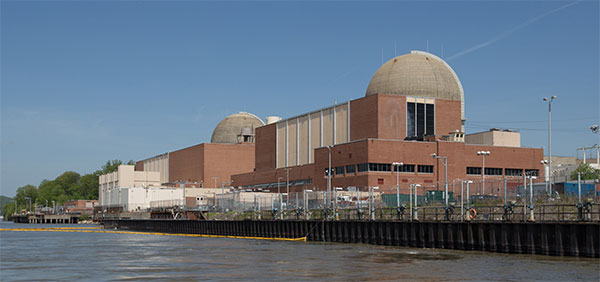Getting in the Holiday Spirit of Improved Public Space

(photo: Michael Appleton/Mayor's Office)
‘Tis the season for improving public spaces.
The 14th Street busway has been live for just over three weeks and the accolades are already enough to deem its opening as historic. New Yorkers are now seeking more innovative ideas to improve the pedestrian and commuter experience throughout the city.
With the holiday season approaching, we are hopeful that this embrace of open space can be adopted in Midtown.
Rockefeller Center is one of the centerpieces of Manhattan. Every year, the area sees close to 1 million pedestrians during the holidays. It’s the must-see destination for both New Yorkers and tourists, and one of the places where the city absolutely shines.
But if you are looking anywhere other than the top of the tree, it’s a sea of people and cars competing to get a glimpse of the scene.
If we think of Rockefeller Center with a people-first mentality, we can make streets safer and enrich public space. That’s why we have called for the City to pedestrianize the historic plaza by closing 49th and 50th Streets from 5th Avenue to 6th Avenue for the holiday season.
The current set up relies on blockades that take up large amounts of space and cause groups of pedestrians to crowd crosswalks and spill over into the street: a recipe for injuries. And each day, the parameters change. With a defined set-up, rules of the area would be more easily communicated and expectations clear.
Ten years ago, Times Square took the jump to clear out cars. Five streets transformed into 110,000 square feet of pedestrian space. The successes of the Department of Transportation's endeavor are indisputable. Pedestrian injuries have decreased by 40% and vehicular crashes have decreased by 15% after the streets became a plaza. The number of individuals passing through increased, too: a boon to area businesses.
Rockefeller Center is a 12-acre landmark in the middle of Manhattan, open to New Yorkers and visitors -- it is time we protect the space and everyone who visits, and encourage even more people to take part safely.
There is nothing like New York during the holidays. Let’s prepare for the celebration and those to come. The countdown is on.
***
Gale A. Brewer is the Borough President of Manhattan. Keith Powers is a City Council Member for Manhattan’s East Side, including the Rockefeller Center area. On Twitter @galeabrewer & @KeithPowersNYC.
***
Have an op-ed idea or submission for Gotham Gazette? Email This email address is being protected from spambots. You need JavaScript enabled to view it.
Keeping the Lights On, and Saving Billions, While Addressing Climate Change

Indian Point (photo: the governor's office)
New York’s recently-passed Climate Leadership and Community Protection Act has been described as the boldest climate legislation in the nation. It sets demanding milestones for reducing carbon emissions, starting with the 2030 goal that New York state should, by then, derive 70% of its electricity from renewable sources (solar, wind, and waterpower). By 2040, it should derive all of its electricity from “clean” sources, and it should be carbon-neutral in all its uses of energy by 2050.
These goals pose daunting challenges, but within two years the challenge will become even greater when the Indian Point nuclear plant, 36 miles up the Hudson River from New York City, is scheduled to shut down. Governor Cuomo agreed to its closure, even though it is functioning safely and economically, because of fears of a nuclear accident raised by the community around the site. When he agreed to the closure, he made a commitment it would not result in any new carbon emissions. Nevertheless, the operator of New York’s electric grid has made clear that three natural gas-powered generating plants will be fired up to replace the carbon-free electricity flowing from Indian Point. These replacement plants will release 7 million metric tons of greenhouse gases for each year thereafter. The increased greenhouse gas emissions will undermine the new climate law before it even gets started, and the smaller capacity of the gas plants may well lead to shortages of electric power in the coming years.
We have shown elsewhere that attempting to meet the new law’s 2030 goal with only renewable sources would cost more than $100 billion and is completely impractical. However, the language of the new climate law ignores the contribution that nuclear power, which emits no carbon dioxide, can make toward a carbon-free future. Indeed, if Indian Point and other nuclear plants, which already provide nearly a third of New York’s electricity, are kept running, and the governor’s planned expansion of offshore wind takes place, a 2030 goal of 70% carbon-free electricity will be met without any further expenditure.
There is no need to shut down Indian Point. This facility, which produces a quarter of the New York City Metro region’s electricity, is safe and reliable and can keep going for decades more. The current closure agreement does allow the plant, if necessary, to continue operating through 2024 and 2025. While the current operator, the Entergy Corp., is giving up control of the plant, the New York Power Authority could take it over and continue operating it, as it did safely and efficiently for many years before Entergy came into the picture. In fact, Indian Point should remain operational until such time as new, carbon-free resources can replace it. That way, it can continue to help meet the state’s emission reduction goals.
We recognize that including nuclear energy, along with carbon-free renewable energy sources, in meeting our climate goals will require a major re-evaluation of risk by groups deeply invested in opposing nuclear power. These groups, some of which campaigned for the closure of Indian Point, are concerned that nuclear reactors will suffer accidents that could have catastrophic consequences. In fact, as one of us has explained in a brief guide, this is not possible. Nuclear reactor accidents have led to very few deaths – 28 plant workers and firefighters perished at Chernobyl, along with an estimated 60 deaths from thyroid cancer worldwide -- and there were zero fatalities from the Three Mile Island and Fukushima events. Hundreds of thousands have already suffered from the effects of climate change, and millions more are likely to suffer if climate change proceeds as it is on course now.
Keeping Indian Point and other nuclear plants operating while the state builds new, even safer nuclear facilities and installs modest amounts of renewable resources offers the most practical, achievable path for New York to meet its emission goals and offer our children and grandchildren a realistic chance for a carbon-free, stable future.
***
Leonard Rodberg is a physicist who taught climate change and public policy at Queens College/CUNY until his retirement in 2017. Herschel Specter is an engineer who focused on nuclear safety issues in many positions, including at the Nuclear Regulatory Commission and the International Atomic Energy Agency.
***
Have an op-ed idea or submission for Gotham Gazette? Email This email address is being protected from spambots. You need JavaScript enabled to view it.
Letter to the Editor: Toy Companies in New York and Across America Put Child Safety First

(photo: @TheToyAssociation)
To the Editor,
As the not-for-profit association representing businesses that create and deliver toys to kids, The Toy Association counts 126 companies in New York State among its membership of more than 1,100 toymakers and retailers. Every single one of these companies prioritizes keeping children safe at play, above all else.
I’d like to set the record straight regarding the mistruths and inaccuracies in Christine Appah’s opinion piece, “The Governor’s Signature is Next Step in Protecting New York Children from Toxic Toys” (Oct. 11).
Appah states that “there are many toys and products on the market today that do indeed contain chemicals that are hazardous to children’s health,” and that the Child Safe Products Act, if signed into law by Governor Andrew Cuomo, could “prevent further unnecessary harm to children on his watch.”
In fact, U.S. toy safety requirements are among the strictest in the world. By law, all toys sold in the United States must comply with more than 100 rigorous safety tests and standards, including the Federal Hazardous Substances Act, the Consumer Product Safety Act, and the Consumer Product Safety Improvement Act. Among other protections, these regulations make it illegal to sell toys or children’s products containing substances harmful to children and to which they might be exposed.
There is a narrative circulating regarding the Child Safe Products Act that’s not based on any scientific studies related to children’s products and oversimplifies a complex issue by saying it will protect kids. In actuality, this bill in no way assesses the safety of the products concerned, and therefore any claims that this would make products safer is simply inaccurate. Disclosure of substances under this legislation is triggered based on their presence and not on any health or safety-based values, and completely ignores whether exposure to the substances is likely or even possible.
What we do know is that the bill will limit consumer choices, as beloved, safe toys that are available elsewhere in the country and internationally will be taken off local store shelves; drive up costs; and threaten 21,000 jobs in New York State.
This legislation fails to consider the numerous federal safety and environmental regulations that all toys sold in the U.S. must comply with. These statutes and ensuing regulations administered by the CPSC already ensure that any children's products that present any hazardous exposure to a child cannot be legally sold in the United States.
Toys are consistently ranked among the safest consumer product categories found in the home. This legislation is trying to solve a problem that doesn’t actually exist.
Rest assured that America’s and New York’s toymakers are committed to keeping children safe.
Sincerely,
Matthew Lenz, Director of State Government Affairs, The Toy Association
@TheToyAssoc
***
Have an op-ed idea or submission for Gotham Gazette? Email This email address is being protected from spambots. You need JavaScript enabled to view it.




